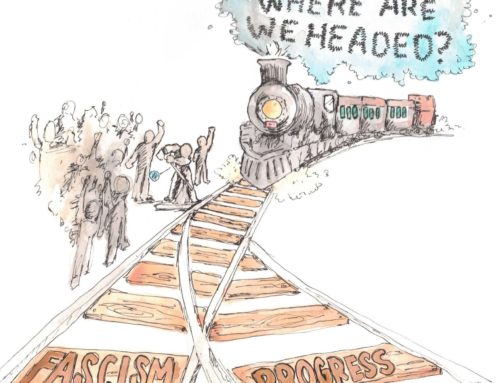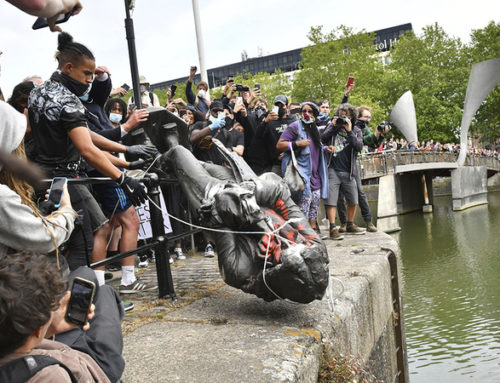Mobilizations and Mass Movements
This is a discussion of two approaches employed in organizing at the mass level: mobilizations and mass movements. Mobilizations typically entail calling on people to participate in rallies, protests and other actions. A mass movement pushes dialogue and strategizing from the revolutionary or intermediate levels to the mass level, building organization and consciousness through continuity of practice.
Mobilizations and organized mass movements are two distinct and essential tools we must wield in our fight to defeat capitalism. They exist in dialectical relation to one another, with the organized mass movement as the main goal. Mobilizations have two roles: they are both a method to build a movement, and they are the outward expression of the organized movement.
The needs of the mass movement should determine the ways in which people are mobilized, and in turn, mobilizations must perennially consolidate and reinforce our efforts to build the movement. The organized movement is the point — any mass mobilizations that do not contribute to building and strengthening it are meaningless activist endeavors that lead nowhere.
Mobilization is the collective response, spontaneous or organized, of the dominated and/or oppressed masses to either oppose measures taken by the dominant classes (defensive), or to make demands that are in their interests (active).
Types of Mobilization:
* Defensive: This is the response (organized or spontaneous) by the dominated and/or exploited masses to reactionary measures taken by the dominant classes in general, or by the capitalist class in the US.
* Active: This is the demand (organized or spontaneous) by the dominated and/or exploited masses for political, social and economic rights. These popular demands pressure the system to change, and while they expose the oppressive nature of the system, these struggles also contain the inherent danger of being co-opted by the system without changing its fundamental exploitative nature, by winning changes in bourgeois law and objectively enlarging bourgeois democracy. Historical examples include the achievement of voting rights for women, the Civil Rights struggle, and the fight for workers rights such as a higher minimum wage and the eight-hour day.
The active mobilization might be used to win some concessions or to “make our voices heard” — in other words, to popularize the struggle more broadly in society. The demands might be partial (presented in stages less than total transformation). If they are, for example, in a workplace, they might be directed at one or a group of industries, and could be local or national. These demands have the potential to affect local industries or even entire societies.
* Spontaneous: Collective spontaneous mobilizations are usually short-lived, with limited demands. Within these types of mobilizations, there is a dialectical relationship between combativity and political consciousness, with combativity being the dominant and determinant aspect. This is a problem because the participants have not adequately defined the nature of the enemy, their demands and their long-term objectives. This makes them vulnerable to being easily pacified and having their demands easily recuperated. Also, when political consciousness is not in command of combativity, a mobilization can become self-defeating and even, in the final analysis, a gift to the bourgeois propaganda machine.
* Organized: Collective organized responses are more defined, with an appropriate balance between political consciousness and combativity. The participants’ understanding of the enemy is deepening, and becomes increasingly rational. They develop the methods to build organization, the capacity to advance, the ability to retreat to defend gains, and to handle repression. This type of mobilization fosters determination and stamina, and can better endure the test of time.
Mobilization does not happen by magic. It is the masses’ response to atrocity or to intolerable conditions. Even if this response is combative, and might appear radical, it could be limited to a demand for reforms and stay stuck in reformism.
It is very difficult to discuss mobilizations separately from the organizational capacity of mass movements. We must also examine the role of the revolutionary and intermediary level organizations in relation to mass movements. Before we define and elaborate on these organizational forms and their relationships, we will discuss two tools of mobilization: agitation and propaganda.
* Agitation: This expresses an issue in a concise manner and calls people to action. Agitational materials include leaflets, posters, radio, television, social networking and other media. Their purpose is to bring issues to the attention of the people through active presence in popular neighborhoods, workplaces and schools as well as to spread them beyond direct contact by using communications technologies like the Internet. Agitation seeks to arouse the outrage of the masses, and to connect with people who are already outraged. Raising political consciousness, though undertaken, is secondary to fostering combativeness.
* Propaganda: This is aimed at raising political consciousness by revealing the underlying reality of an issue through theoretical analysis. Propaganda materials include newspapers and newsletters, web sites and discussion forums, conferences and debates, and one-on-one discussions. Their purpose is to facilitate the masses’ collective understanding of the internal contradictions that give rise to external (or visible) manifestations of phenomena, and to engage in political dialogue with the masses to move discussions forward on questions relating to revolutionary transformation.
Agitation and propaganda foster a dialectical relationship between the popular masses and the organizational structures (mass, intermediary and revolutionary organizations). These structures must be comprised of the masses (the classes, fractions of classes and social categories) they aim to organize. The purpose of agitation and propaganda is to construct and develop organizations at all levels. The purpose, in turn, of these organizations is to facilitate autonomous collective power, capacity and consciousness at all levels.
For agit/prop to be effective at mobilization, it must express the character of the dominated and/or exploited classes that it is directed to. We must, at all organizational levels, be very aware of whom we are addressing and the interrelations between the various classes. For example, many students have a middle class background, while another large sector of students have parents who are in the working class and/or the social category of working people, and some students are working people themselves. To be effective, agit/prop must take these factors into consideration.
In creating effective agit/prop, organizations are well advised to implement the Mass Line, which is an organizing method that bases itself on the principle “from the masses, to the masses.” This means participating in the struggles of the masses, basing our practice on their concerns and ideas (as well as objective conditions), and bringing to these struggles our understanding of the nature of the system and the goal of transformation.
This back-and-forth relationship between the organized level and the masses can help us avoid these common errors:
* Tailgating the masses (expressing the lowest common denominator and weakening our demands)
* Sending wrong messages
* Making erroneous calls for action that don’t correspond to the mood of the people or objective conditions
* Over- or underestimating the capacity of the masses or sectors we are trying to mobilize
* Misunderstanding the conditions, or the relative strength and weaknesses of the popular forces in relation to the enemy
* Proposing pompous slogans that don’t connect with people, with long-term demoralizing and demobilizing effects
* Falsely inflating the struggle through exaggeration, which inevitably leads to deflating it
Goals are long-term aims; priorities are immediate activities along the path to our goals. We should not confuse the two, but always be clear about the dialectical relationship between them. Once we define our goals, we can work out our priorities. Mobilizations are priorities– they are mainly a tactic to gather forces (keeping in mind both quantitative and qualitative concerns) to build organized mass movements.
The mobilizations of students in the 1960s did not clearly define goals, or demarcate the line between goals and priorities. As a result, the mobilizations ended up becoming the movement themselves, rather than being an integral (yet distinct) element in constructing the movement. This resulted in the compartmentalization of the mobilizations into various political organizations that became isolated from the masses, and the dissolution of the mass movement.
Mobilizations can represent the interests of a variety of classes, and must be differentiated accordingly. Lately, reactionary mobilizations have been defending the interests of different sectors of the capitalist class in the US, represented by the competition between the Republican and Democratic parties. The contradictions between these sectors are secondary to their commonality — there is no road to revolution, nor even the possibility of significant reform, within the current capitalist/imperialist framework. Even when mobilizations appear populist, if they represent any fractions of the capitalist class they are, today, inherently reactionary. This is true of both the Democrats’ recent One Nation rally, and the right-wing Tea Party mobilization.
We must define a political line to divert the vast sections of the masses who are currently being led by these reactionary classes. We must win them over to our side, while avoiding the pitfalls of class collaborationism and opportunism/populism. When we initiate mobilizations with the goal of constructing mass democratic organizations and combative mass movements, our orientation must be anti-exploitation, anti-domination and anti-imperialist.
The role of organized structures:
The revolutionary level and the mass level are interdependent and at the same time autonomous. To survive, they must relate to each other dialectically, each affecting and helping the other to realize its potential and aims.
Two aspects of their relative autonomy must be understood:
* The autonomous practice of the revolutionary level in pursuing its particular objectives
* The presence of the revolutionary level within the mass organization
Here we will discuss only the latter. When working within the mass level, the revolutionary has several objectives:
* To struggle against reformist tendencies. There is a thin line separating the struggle for reforms, and having a reformist political orientation, or line. The danger of recuperation by the bourgeoisie of struggles for reforms is constant, since most reforms, if won, will become bourgeois laws.
* To build political rapprochement with the masses to define which mobilizations for reforms are a priority. These mobilizations are not a goal in themselves — they are tactical in nature and in content, and their goal is to constantly weaken the system and strengthen the revolutionary potential of the organized masses. These are perennial under capitalism.
* To expose the fact that at this stage of imperialism, capitalism has reached its peak and is reactionary to the core, and can not reform itself. To make demands for reforming it is useless.
* To participate in the construction of combative mass organizations, in a manner that takes into account their purpose in the present and future. In the pre-revolutionary stage, they act as instruments of struggle against exploitation and domination. In the post-revolutionary period, they will be instruments of power against the defeated capitalist class that is struggling to regain ascendancy.
The conceptualization of these mass organizations is not pre-determined, but will unfold during the process of struggle. As instruments of struggle and power, they need to be constructed in forms that are highly democratic, if they are to be resilient and creative enough to challenge and defeat the dominant system. The underpinning and fundamental elements of power must be popular democratic structures and practice.
The masses must control all organized structures. Trust must be built between the revolutionaries and the masses. Accountability will be essential in theory and in practice.
Errors to avoid:
* Revolutionaries should avoid the vanguardist mentality that would lead them to attempt to bureaucratically control mass organizations, or mechanically take leadership of them. If this error is made, the mass level structure will rapidly become a front organization, the masses will abandon it, and it will degenerate into a head without a body.
* We must avoid confusing the two levels. Instead we must conceptualize the two levels in our theoretical model, and respect their relative autonomy. If we make the error of bringing revolutionary level discussion into the mass level, we render the latter obsolete and sterile. This would have the consequence of depleting the mass levels, since the democratic structures for its views to manifest would no longer exist.
The intermediary level
The objective of the intermediary level is to participate alongside and in some unity with the revolutionary level (but short of that level) to construct mass level organizations. The intermediary level is comprised of large political organizations organizing within the popular classes and/or social categories, with the goal of building combative mass organizations, and participating as the most politically advanced detachments of their classes in the struggle against exploitation and domination, in the ways most appropriate to the current historical period.
Points for further reflection and future elaboration:
* At what point the intermediary level organization becomes a mass organization.
* When this happens, what happens to the initial or most advanced core?
* How to avoid being a front group.
* Be theoretically aware of the moment we are in, and appropriately navigate the inevitable waxing and waning of opportunity.
* Identifying the classes and social categories to organize. This should reflect the social origin of the initial core and/or the class position of the initial core.
* Build a democratic structure of functioning from the start. (This doesn’t necessarily mean that the organization is open). The intermediary level/large political organizations are the embryonic constructions of mass organizations as instruments of struggle and instruments of power.
* Unity should be built around theoretical models, rather than around individuals.
Each of the points addressed in this presentation should be further developed as part of a theoretical model to be produced and constantly questioned. The objective of this piece is to lay the groundwork for constructing combative mass organizations.






[…] Posted by Mike E on December 12, 2010 The following essay was sent to Kasama for publication, by the anti-capitalist, anti-imperialist collective One Struggle – South Florida. […]
For an essay defining and discussing the Intermediate Level, please see: “The Intermediate Level Analysis” by Miami Autonomy and Solidarity: http://miamiautonomyandsolidarity.wordpress.com/2010/11/24/the-intermediate-level-analysis/.
[…] Mobilizations and Mass Movements (onestrugglesouthflorida.wordpress.com) […]
[…] Mobilizations and Mass Movements (onestrugglesouthflorida.wordpress.com) […]
[…] movement to combat the whole arrangement of society, we need to understand the relationship between mobilization and mass movement.. Mobilizations entail calling on people to participate in rallies, actions. A mass movement pushes […]
[…] stoked to see so many people fired up and in the streets! We aim to do our part to help grow these mobilizations into a movement… one capable of radically altering this […]
[…] Mobilizations and Mass Movements […]
[…] Mobilizations and Mass Movements […]